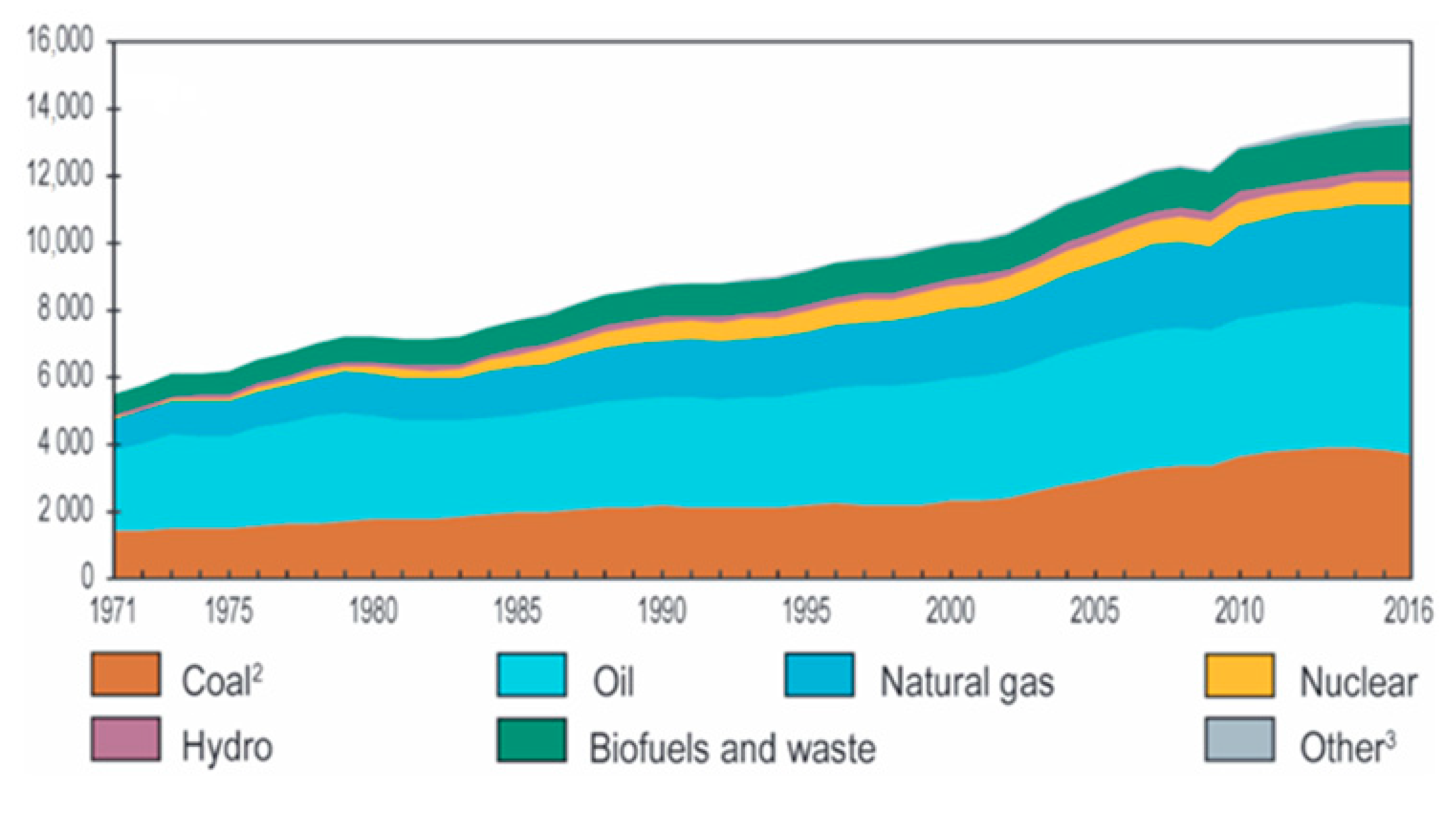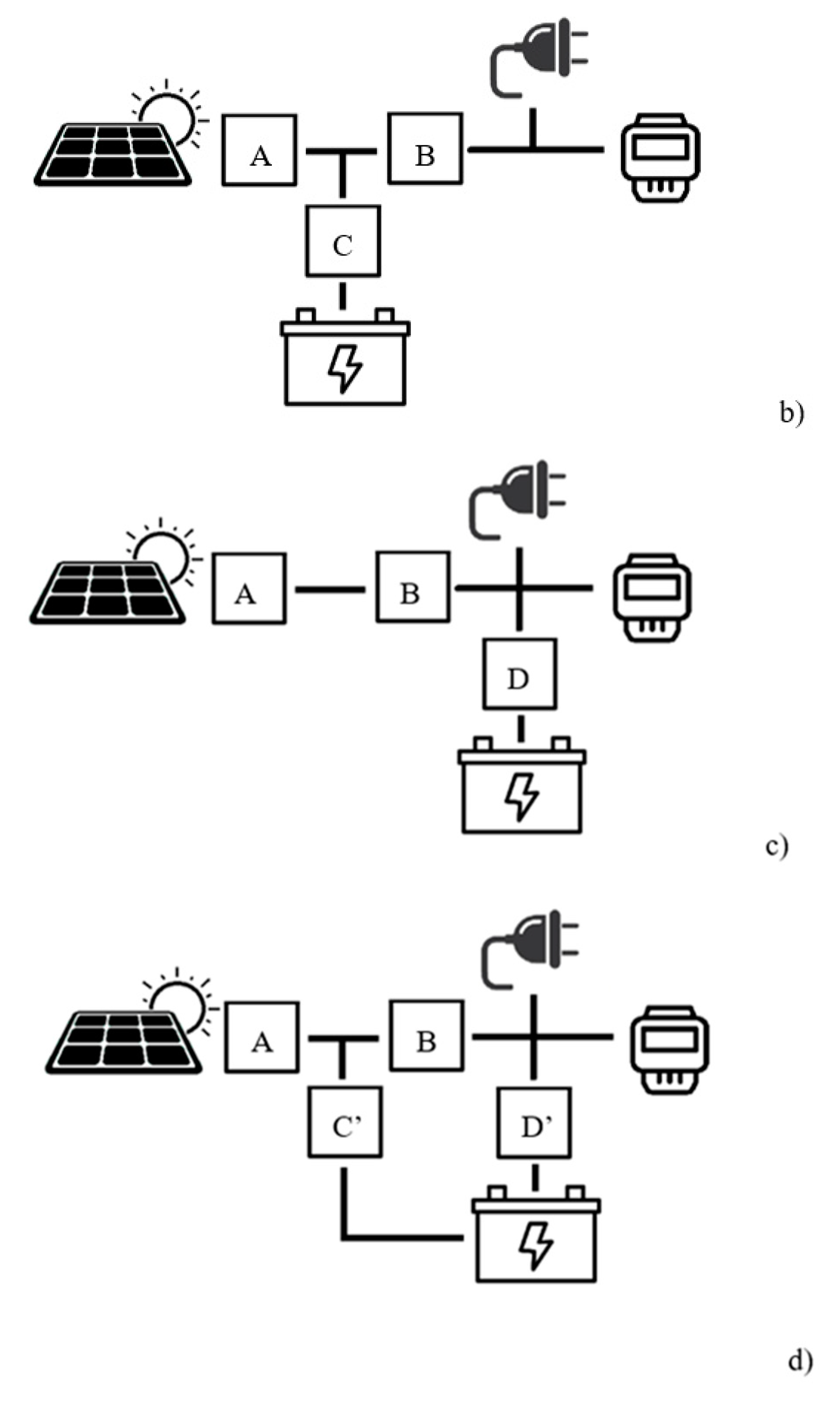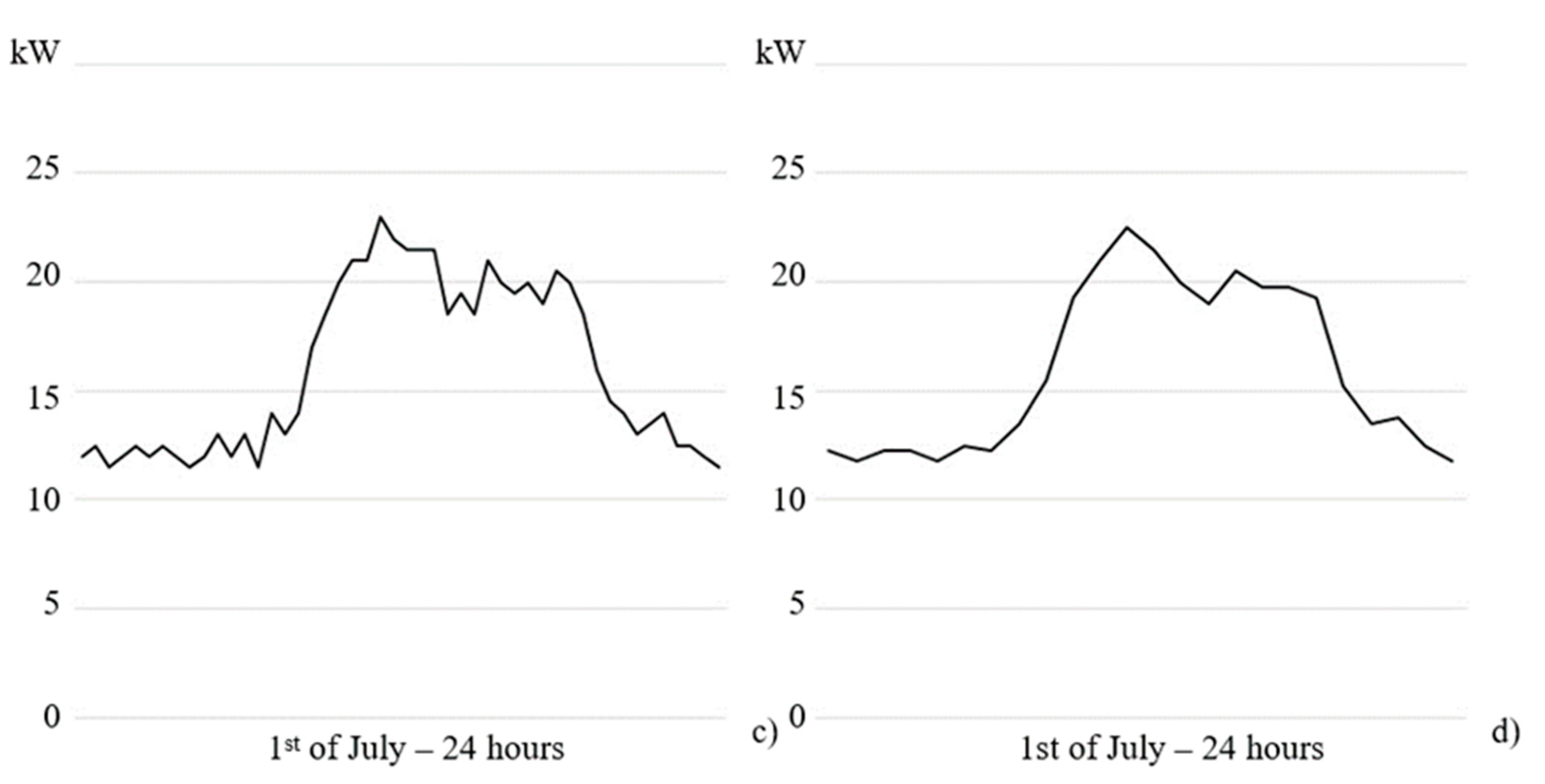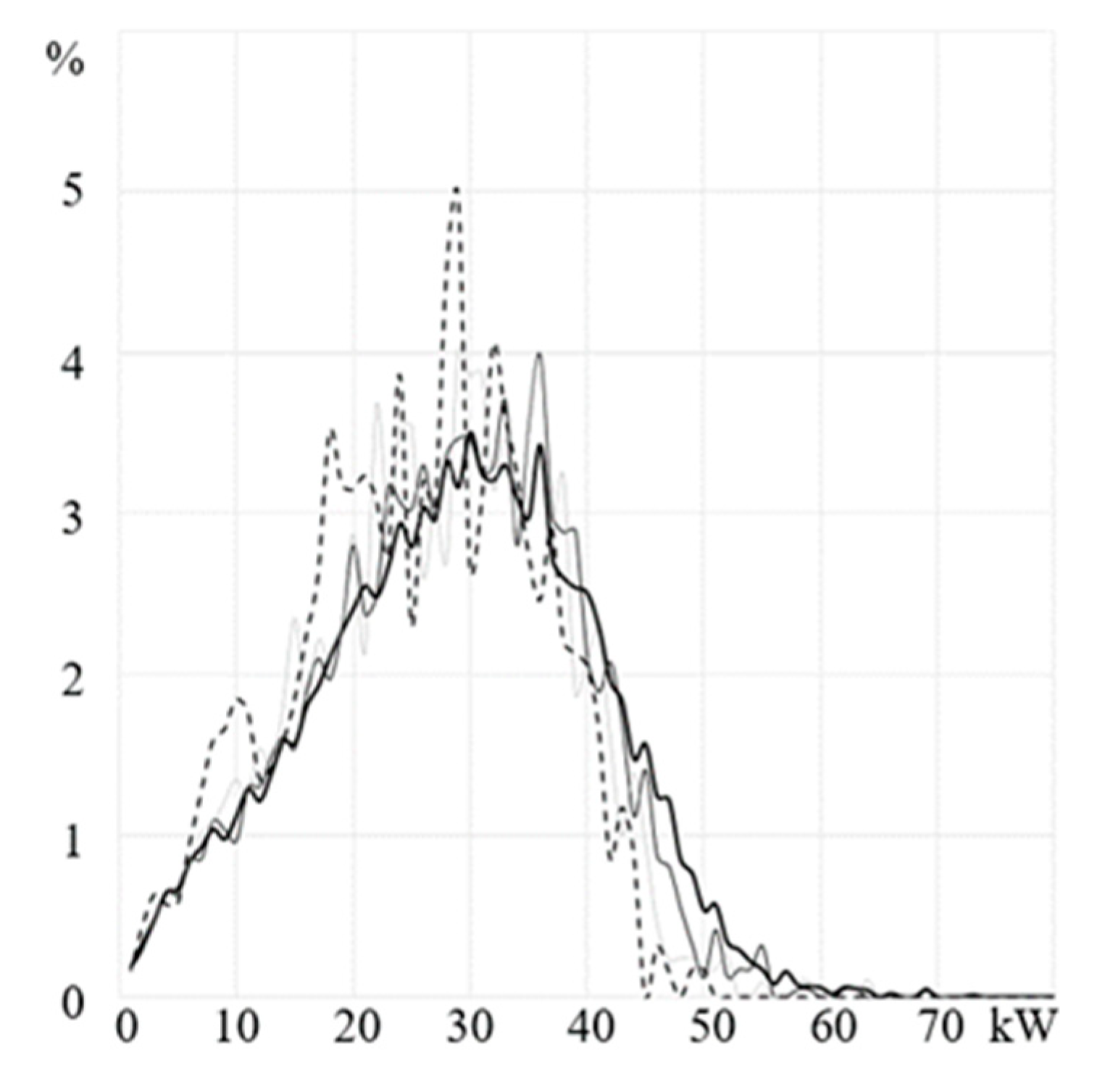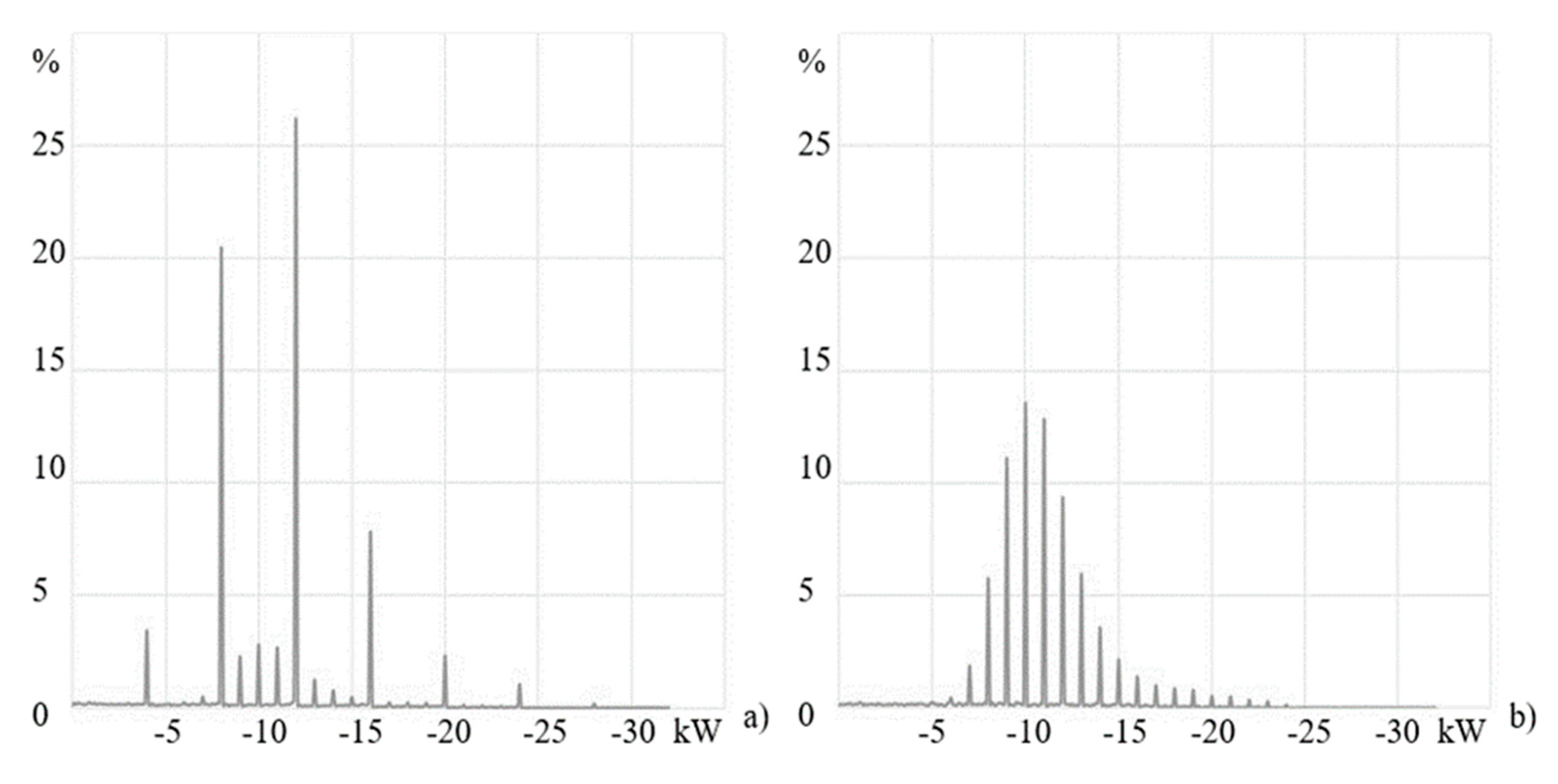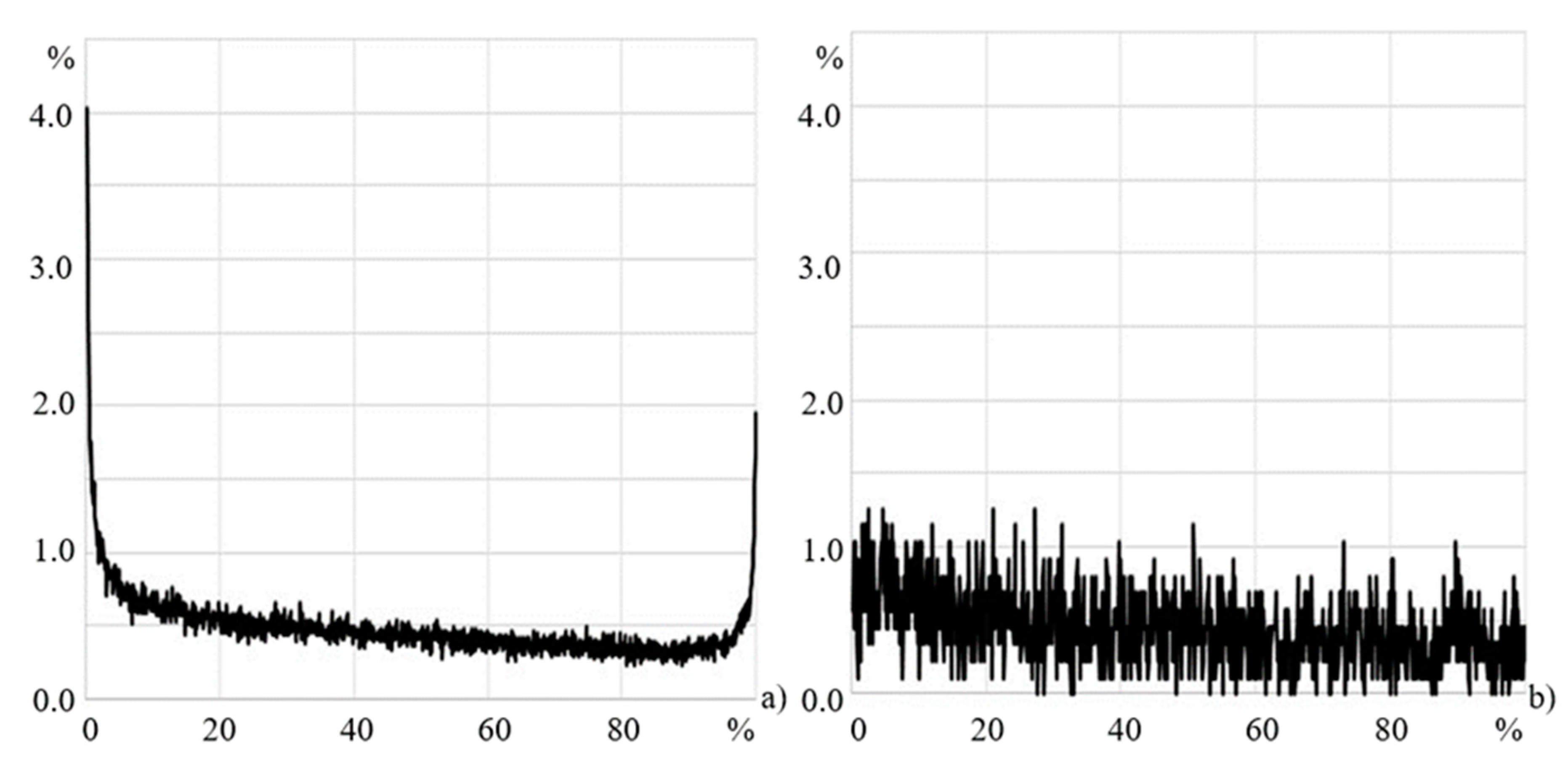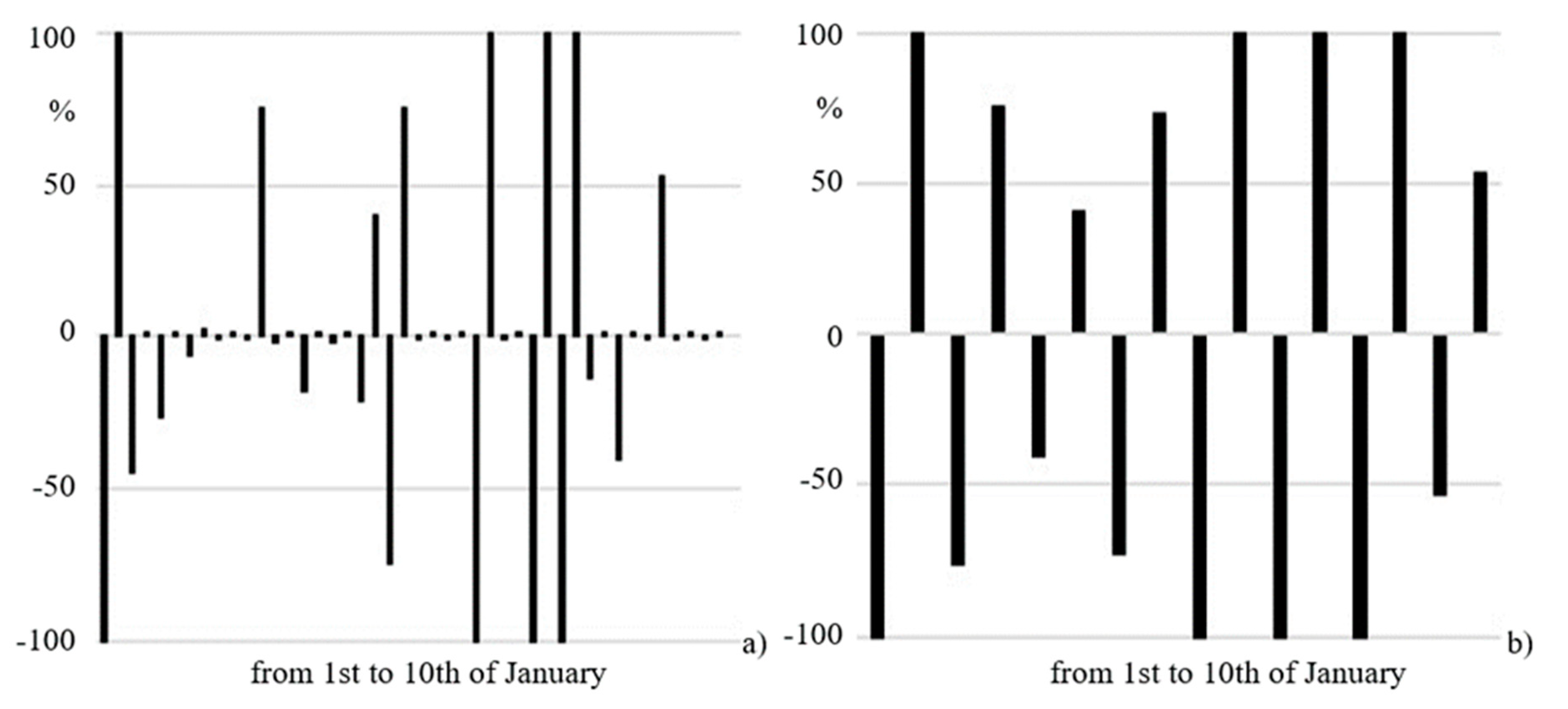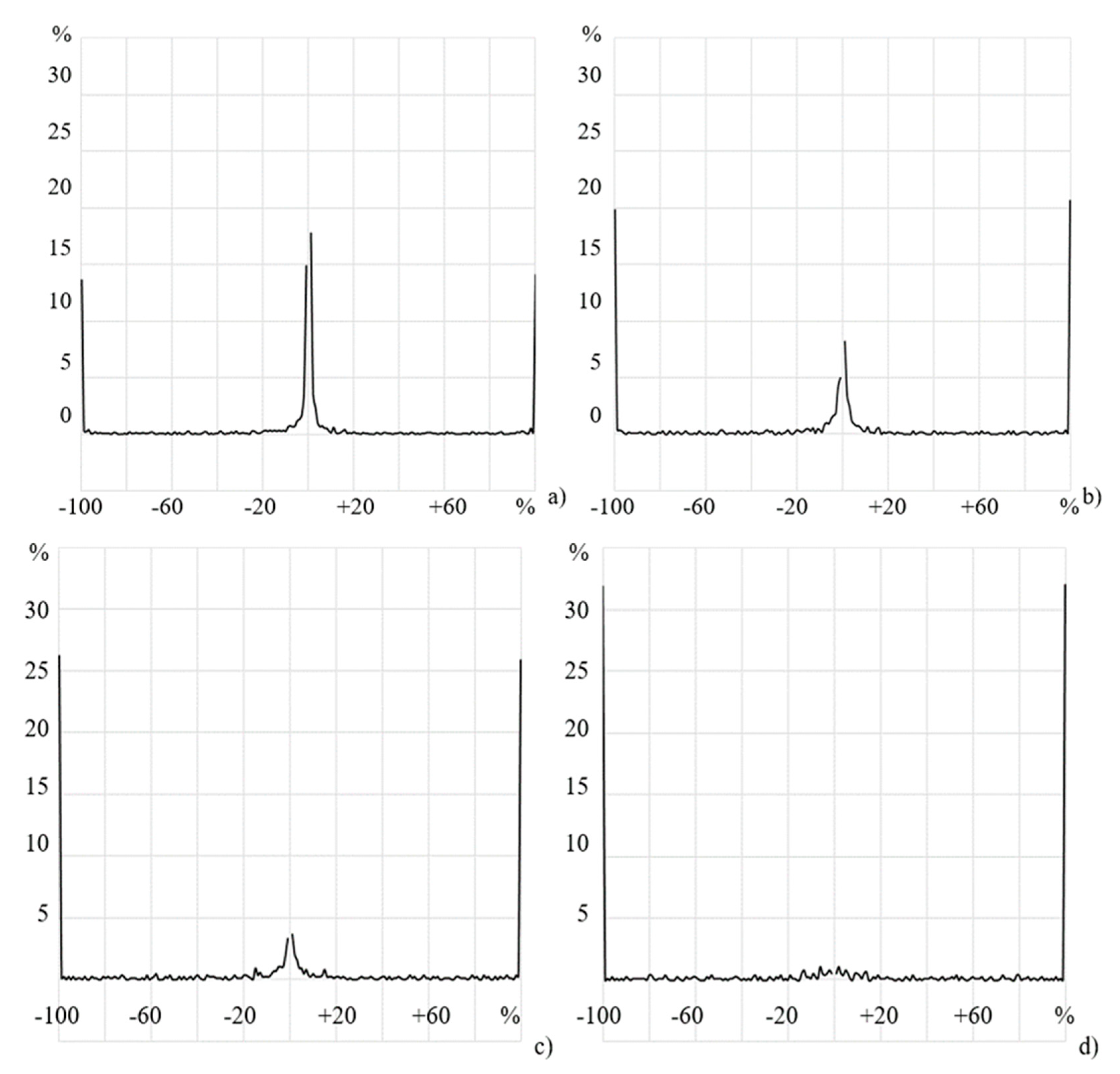This section illustrates the results of numerical experiments with reference to a real case study.
3.3. Influence on the Size of the Photovoltaic Generator and Capacity of the Battery Energy Storage System
The model of the PV&BES system, shown in
Section 2 of this paper, is now used to optimal sizing both the photovoltaic generator and the battery energy storage system; the optimal solution minimizes the cost function, it ensures that the self-generation rate is equal to 100% and the self-consumption rate is 70%. When R3 is considered, the optimal size for the photovoltaic generator is 83.38 kW while the optimal capacity of the batteries storage is 105.17 kWh, as reported in the first column of
Table 3. Such a calculation is now repeated with reference to R15, R30 and R60; the remaining columns of
Table 3 show that the optimal size of the photovoltaic generator remains unchanged and equals 83.38 kW, while the optimal capacity of the batteries slightly decreases from 105.10 kWh to 103.01 kWh (−1.98%). The conclusion is that the temporal resolution has no particular relevance in the optimal sizing of the PV&BES system, as time averaging from 3 to 60 min does not imply any relevant error; for the case studied, time averaging underestimates the capacity of the batteries storage system by only 2%.
The second half of
Table 3 reports the energy E
PV produced by the photovoltaic generator during the year, the energy E
BES stored by the batteries during the year, the energy E
IMP imported from the grid during the year as a function of the temporal resolution; the value of E
PV does not vary and remains equal 121.64 MWh, the value of E
BES decreases from 30.69 MWh to 29.25 MWh (−4.69%), the value of E
IMP increases from 36.49 MWh to 37.93 MWh (+2.84%). These results clearly indicate that the temporal resolution has small influence on the calculation of energies E
PV, E
BES and E
IMP therefore it is easy to deduce that the influence of the temporal resolution on the electricity bill and savings is equally irrelevant. In this respect, the first column of
Table 4 shows the electricity bill, when calculated in the absence of both the photovoltaic generator and the storage system, i.e., Bill
w_outPV&BES, is €11,769.39, where €7501.81 (63.74%) is for the electricity consumption and €4267.58 (36.26%) is for taxes and VAT. Adopting the hybrid PV&BES system, the bill reduces to €3562.33 therefore the saving is about 69.73%. On the other hand, some additional costs exist: The annual installment for the photovoltaic generator is, €15,077.46 and the annual installment for the storage system is €3214.79; therefore, the balance between savings and installments is €−10,085.18. When the temporal resolution varies from 3 min to 60 min, the balance varies by +0.04%. Therefore, the conclusion is that the temporal resolution has no relevance on the calculation of the balance between savings and costs when a hybrid PV&BES system is adopted.
3.4. Influence on Power Flows During an Over Generation
This section discusses the influence of the temporal resolution on peak values of these four profiles: P
LOAD, P
LOAD − P
PV, P
BES and P
ESP; they are the load profile, the difference between the load profile and the photovoltaic generator profile, the profile of the battery storage system, and the profile of the power exported to the utility grid, respectively. As reported in the first column of
Table 5, the peak of P
LOAD is 52 kW and it significantly decreases to 31.50 kW as the temporal resolution changes from R3 to R60. The conclusion is that a 60-min temporal resolution can cause a substantial under-estimation (39.42%) of the peak value of the load profile; since current peaks are under-estimated too, the estimation of the number of times that the electric cables are overloaded is jeopardized [
15].
When negative, the difference P
LOAD − P
PV indicates that the photovoltaic generator produces more than the load demand; in this case an over generation is in progress and the batteries can be recharged. Worth noting is that P
LOAD − P
PV is the power available for the recharge and that it does not necessarily coincide with P
BES. The peak value of P
LOAD − P
PV is 77.12 kW for R3 and it decreases to 60.83 kW for R60 (−21.12%), as shown in the second row of
Table 4. Similarly, the peak value of P
BES is 73.27 kW for R3 and it decreases to 60.83 kW (−24%) for R60, as shown in the third row of
Table 3. The peak value of P
BES is lower than the peak value of P
LOAD − P
PV because of two reasons; the first relates to the state of charge. Indeed, if the storage system is fully charged then the over-generated power is necessarily exported to the grid or locally dissipated, penalizing the self-consumption rate. The second relates to the rated power of the electronic converter, which regulates of the battery recharge; if such a rated power is lower than the peak value of P
LOAD − P
PV than a part of the over-generated power is necessarily exported to the grid or locally dissipated, further penalizing the self-consumption rate. The estimate of the decrease of the self-consumption rate, due to the under-estimation of the rated power of the batteries recharger, requires precise numerical calculations because it depends on how many times, and for how long, the rated power of the recharger is found to be lower than P
LOAD − P
PV. For example, a battery’s recharge with a rated power equal to 60.83 kW, i.e., the peak value of P
LOAD − P
PV for R60, instead of 73.27 kW, i.e., the peak value of P
LOAD − P
PV for R3; the numerical results returns a self-consumption rate still of 70%. The conclusion is that a coarse temporal resolution can induce the under-sizing of the power converter that regulates the recharge of the batteries; in this case, a part of the power generated by the local generators is necessarily exported to the grid or locally dissipated, thus penalizing the self-consumption rate. The estimate of the reduction in the self-consumption rate requires specific calculations, case by case. Lastly, the fourth row of
Table 5 shows the peak value of P
ESP that is the power flow exported to the utility grid; this peak value is 77.02 kW for R3 whereas it is 60.83 kW for R60 resolution (−21%). The conclusion is that the coarse temporal resolution can induce the under-estimation of the feed-in contractual power.
3.6. Influence on the Utilization Rate of the Storage System
The influence of the temporal resolution on the calculation of the utilization rate of the storage system is investigated in this paragraph by distinguishing three cases: The storage system is in stand-by mode, recharging, and discharging. The stand-by mode indicates that the batteries storage is functioning, but the output current is zero or almost zero; therefore, the longer the stand-by mode, the lower the utilization rate of the storage system. In order to estimate the utilization rate, P
BES provides the necessary information. Indeed, P
BES is a string of values whose cardinality depends on the temporal resolution; for example, if the temporal resolution is three minutes then the cardinality of P
BES is 175,200 values. The authors assume being null the values belonging to the range of ±0.10 kW. Given this assumption, half of P
BES (50.31%) is null when the temporal resolution is 3 min, the utilization rate of the storage system is 49.69%, as reported in the first column of
Table 7. The utilization rate increases from 49.69% to 51.29% when the temporal resolution changes from 3 to 60 min. The conclusion is that the poor temporal resolution scarcely influences the estimate of the utilization rate of the storage system.
It is important to underline that the low utilization rate mentioned above is due to the strategy that regulates the operation of the storage system and it is not due to the temporal resolution. Indeed, the adopted strategy means batteries’ recharge occurs exclusively in the presence of an over generation, while the batteries’ discharge occurs exclusively in the presence of under-generation; this strategy excludes any exchange of power between the storage system and the grid.
This strategy clearly limits the use of the storage system and, consequently, the utilization rate. Finally,
Table 8 shows the utilization rates when calculated for March, June, September, and December. The utilization rates in March vary with the temporal resolution but they coincide almost exactly with the utilization rates for the whole year. In contrast, the storage system gives a higher contribution to the PV&BES system in June, compared with March; indeed, the rates reported in the third row of
Table 8 show higher contribution of about 10%. The utilization rates in September are in the middle between March and June. Finally, December is the month with the lowest utilization rates since the storage system remains inactive for about 60% of time, regardless of the temporal resolution.
3.7. Influence on the Recharge of the Storage System
The previous paragraph has studied the profile of the storage system and it has paid attention to null values only, thereby calculating the utilization rate and evaluating the influence of the temporal resolution on it. This paragraph focuses on positive values of P
BES, i.e., those values that indicate the batteries recharge. As reported in the third and fourth rows of
Table 7, the batteries recharge covers the 17.60% of P
BES and the average value is 19.89 kW when a three-minute temporal resolution is adopted. The authors approximate these values to integers and calculate their recurrences; as an example, the string {5, 7, 9, 9, 9, 5, 5, 5, 5, 5} has ten integers, the number 5 recurs six times or its recurrence is 60%, the recurrence of number 7 is 10%, the number 9 counts for 3 times therefore its recurrence is 30%. This said,
Figure 4a illustrates the recurrences of values of the battery storage profile when the temporal resolution is 3 min; in the Figure, 10 kW recurs 0.1% since the number 10 counts in P
BES approximately for 176 times.
Figure 4a also shows that all values in P
BES recur less than 0.3% and that none of the values prevail.
Figure 4b–d show the recurrences when the temporal resolution is 15, 30 and 60 min, respectively. A conclusion is: the recurrences of the values belonging to P
BES do not vary appreciably when the temporal resolution varies; given a trend line, the dispersion of the values increases as the temporal resolution get worse.
The calculation of the recurrences of P
BES in
Figure 4 can be a valid aid to sizing the power electronic converter that regulates the batteries; recharge. Indeed, while examining the
Figure 4, it can be noted that the values greater than 40 kW recur less than 0.05%, therefore, 40 kW is a valid size of the power converter. In fact, sizing the batteries’ recharger, and taking into account the recurrences of values of P
BES, is not sufficient; the corresponding values of energy have to be considered as well. In this regard,
Figure 5 associates the values of P
BES and the corresponding values of energy stored in the batteries, according to the temporal resolution.
Figure 5 shows that all the four curves merge into one and that the energy stored in the batteries for power higher than 40 kW is about 18.56%. Therefore, a 40 kW batteries recharge is no longer a valid choice, since it penalizes self-consumption in a non-negligible way. A 51 kW batteries recharger is more reasonable since, according to
Figure 5, it affects the self-consumption by 2.28%. The conclusion is that the temporal resolution does not significantly affect the estimate of the amount of electrical energy stored in the storage system, including the correspondence between the stored energy and the respective values of powers.
3.8. Influence on the Discharge of the Storage System
The two previous paragraphs have studied the profile of the storage system and they have paid attention to positive and null values; this paragraph focuses on the negative values of PBES, which indicate the discharge of the storage system.
When the temporal resolution is 3 min, the discharge of the storage system covers the 32.46% of P
BES and the average value of powers during the discharge is 10.78 kW, as in the fifth and sixth rows of
Table 7. The authors approximate these negative values of P
BES to integers and calculate their recurrences, as already explained and done in the previous paragraph.
Figure 6a shows the recurrences of values of P
BES. Some of these values clearly recur more than others and cause spikes. Recurrences of 12 kW, and 8 kW are 26.24%, and 20.50%, respectively. These two values count almost half of the recurrences. With the exception of 16 kW, which recurs approximately 3%, the remaining values have negligible recurrences. As the temporal resolution get worst, the distribution of recurrences changes and it completely loses spikes. Indeed, the distribution of recurrences for R15, R30 and R60 shown in
Figure 6b–d clearly indicates that the more the temporal resolution get worst, the more the discharge of the storage system tends to a unique value, that is 10 kW. The conclusion is that the three-minute temporal resolution allows a set of powers to be identified most frequently exported by the storage system. In other words, the discharge of the storage system takes place in correspondence with a restricted set of power values. The 60-min temporal resolution causes the total loss of this information; the discharge tends to concentrate in the close neighborhood of a single value that, in a high temporal resolution, might count zero times.
3.9. Influence on the State of Charge of Batteries
The previous three paragraphs have studied the influence of the temporal resolution on the utilization rate, the recharge, and the discharge of the storage system. The batteries storage system profile has been the basis of such a study. This paragraph illustrates a similar study but, this time, the basis of the study is the profile of the state of charge (SOC) [
48]. As usual in this field, such a profile is a string of numbers in the range 0–100%; the string length depends on the temporal resolution, it decreases from 175,200 to 8760 values when the temporal resolution changes from 3 to 60 min. The recurrences of SOC’s profile for a three-minute temporal resolution are reported in
Figure 7a; this temporal resolution returns a fairly sharp curve where most of the recurrences are equal to about 0.05%. Two spikes are on the range boundaries: If the SOC tends to 0% then the recurrence tends to 4% while if SOC tends to 100%, then the recurrence tends to 2%.
The recurrences of SOC’s profile for a 60-min temporal resolution are reported in
Figure 7b; recurrences remain below 1% and no value prevails with respect to the others. The conclusion is that the calculation of recurrences of SOC’s profile is a useful aid in understanding the use of the batteries storage system, but the 60-min temporal resolution compromises the effectiveness of such a calculation as it flattens the distribution of recurrences, forcing them into a restricted range.
The calculation of recurrences of SOC profile is not the solely useful aid in understand the use of the batteries storage system; an alternative exists namely the extraction of the increasing and decreasing substrings from the SOC profile. As an example, the SOC profile is a string of numbers in the range 0–100%; this profile is now divided into M substrings,
where an ascending substring indicates a partial or total recharge whereas a descending substring indicates a partial or total discharge. For sake of simplicity, an ascending substring from 28% to 48% is named sub (+20%) whereas sub (−30%) indicates any descending substring which accounts for a partial discharge of 30%.
This said, the SOC profile in the first ten days of January is divided into M = 240 substrings for a three-minute temporal resolution, or into M = 16 substrings for a 60min temporal resolution. These substrings are shown in
Figure 8. The three-minutes temporal resolution allows the true understanding of the use of the batteries. In
Figure 8a the storage system executes four 100% recharges, two 75% recharges, one 50% recharge and one 40% recharge; it also executes four 100% discharges, one 75% discharge, two 50% 50% discharges and five discharges within 1–25% range. The 60-min temporal resolution makes the identification of the use of the batteries less precise, indeed in
Figure 8b the storage system executes eight discharge/recharge cycles in alternation: Four 100% discharge/recharge, two 75% discharge/recharge, one 50% discharge/recharge and one 40% discharge/recharge. The conclusion is that the 60-min temporal resolution simplifies the use of the storage system, masks both the charges and discharges with small amplitude, and promotes those with a larger amplitude.
The conclusion reported above is the result of a ten-days period of observation, from the 1 to 10 January, It is opportune to verify such a conclusion over a wider period, i.e., the entire year. To this end,
Figure 9a shows the recurrences of all substrings of the SOC profile for a 3-min temporal resolution. On the left of
Figure 9a, sub (−100%) indicates a full discharge and it recurs 13.63%; on the right of
Figure 9a, sub (+100%) indicates a full recharge and it recurs 14.10%. Recurrences of full discharges and full recharges almost coincide each other.
Figure 9a also shows that almost all the remaining substrings have negligible recurrences, except for the substrings in the narrow range around zero, i.e., sub (±4%) whose recurrence is about 15–20%. Similarly,
Figure 9b–d show the recurrences for temporal resolutions equal to 15, 30 and 60 min, respectively; an evident result is that recurrences of both sub (−100%) and sub (+100%) progressively increase up to about 32%, that is a value two times greater than that measured with a 3-min temporal resolution. Another evident result is that the recurrences of the substrings in the narrow range around zero, i.e., sub (±4%), tends to zero. The conclusion is that dividing the profile of the state of charge of the storage system into substrings and studying these substrings is a valid tool to understand the use of the batteries. The temporal resolution affects the validity of the results from this study, and in particular, the 60-min temporal resolution strongly simplifies the operation of the batteries that tends to an alternation of recharges and discharges of equal amplitude.
Dividing the profile of the state of charge of the storage system into substrings is also a valid tool to estimate the lifetime of the batteries because the recurrences of substrings contributes to estimate the number of equivalent cycles of the storage system. To this end, the second row of
Table 9 shows the recurrences of substrings from sub (−100%) to sub (−94%) and from sub (+94%) to sub (+100%); substrings from sub (−93%) to sub (+ 93%) are not considered since they count almost zero. The number of equivalent cycles of the storage system is so estimated:
The number of equivalent cycles
EFC1 returned by Equation (35) depends on the temporal resolution; as in
Table 9,
EFC1 is approximately 232 for a 3-min temporal resolution while it is 242.50 (+4.52%) for a 60-min temporal resolution. The conclusion is that the recurrences of substrings of the SOC profile allows the number of equivalent cycles of the storage system to be calculated which, in turn, allows the lifetime of the batteries to be estimated. Such a calculation is negatively affected by a coarse temporal resolution as the 60-min temporal resolution induce the over-estimation of the number of equivalent cycles by 4.52%.
It is worth pointing out that Equation (35) returns an estimate that is an approximate calculation of the degradation of the storage system. This is because such a formula does not take into account the type of batteries, the operating temperature, the nominal current, or the nominal voltage. Although, all these factors affect the degradation process. Equation (35) can be used in combination to an analogous equation proposed by Berrueta et al. in [
49],
where |
i| is the absolute value of the battery current in amps, where C is the battery capacity in Ah. The number of equivalent cycles
EFC2 returned by Equation (36) is reported in the penultimate row of
Table 9. It is approximately 247 for the temporal resolution of 3 min, and about 216 (−12.55%) when the temporal resolution is 60 min. The difference between
EFC1 and
EFC2 is very small; actually it is irrelevant if compared with respect the 4500 cycles of the modern LiFePO4 lithium polymer batteries [
50,
51]. Although,
EFC1 and
EFC2 are estimates, they are input data for sophisticated formulas for the batteries aging analysis. As an example, when Wang et al. [
52] studied a lithium battery mod. Sanyo UR18650, they grouped the capacity fade and the impedance rise, and thus, obtained the following formula useful to estimate for the decrease of state of health:
where
i is the battery current in amps,
C is the battery capacity in Ah, |1/
C| is the normalized current,
t is the time expressed in days,
T is the operating temperature in Kelvin, and
R is the gas constant. Equation (37) is the sum of two negative terms where the first is a function of the current, of the capacity and of the equivalent number of cycles, while the second term is a function of the time and the operating temperature. The decrease of state of health returned by Equation (37) is reported in the last row of
Table 9; the degradation is 56.09% when calculated with a 3-min temporal resolution, whereas, it is 43.43% when calculated with a 60-min temporal resolution. It is important to note that these values have been calculated using
EFC2 and by assuming that the operating temperature remains constant and equal to 20 °C. The latter assumption implies that the second term of Equation (37) is 21.9% per year. The conclusion is that the 60-min temporal resolution causes under-estimation of the degradation of the state of the health by about 13%.
